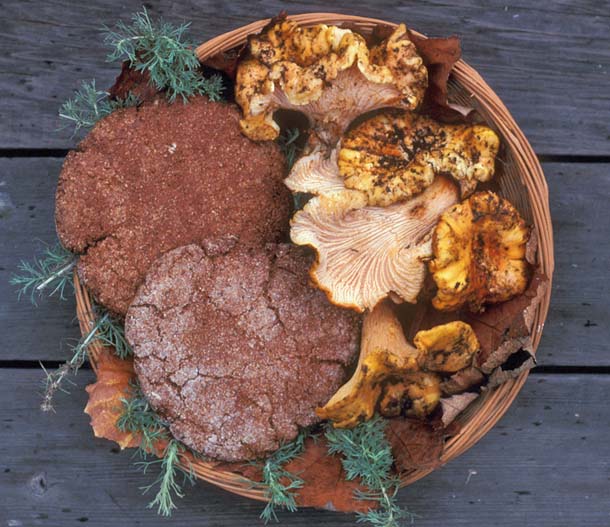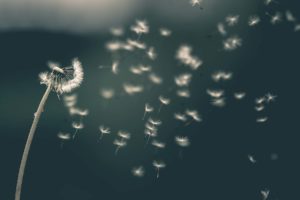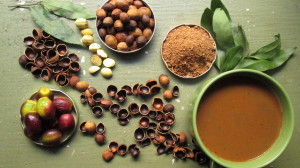Euell Gibbons called it “stalking” in his 1962 best seller, Stalking the Wild Asparagus, which launched the contemporary foraging movement and made him one of my outdoor role models. Like Gibbons, I’ve foraged on the East Coast, mostly for shellfish in Long Island Sound, and on the West Coast, for blackberries, quail eggs, fennel, and much more. But I’ve always thought of myself as a common scavenger rather than as a “forager,” a word redolent of European forests and feudal lords.
Whether one calls it foraging, scavenging, gathering, or stalking, it’s now at a cultural and environmental crossroads. Foraging information has spread through websites, newspapers, magazines, books, and word of mouth. Every year, it seems, more naturalists, foodies, and commercial foragers tromp into woods, fields, and pastures. How many is impossible to say: No one keeps statistics on them, or on the supply of the wild foods they’re seeking. Unlike hunting and fishing, both tightly regulated, foraging–defined roughly as gathering (rather than catching or shooting) wild foods–remains an under-the-radar pursuit.
Still, anecdotal evidence from Bay Area foragers suggests the demand for edible wildflowers, roots, mushrooms, and fruits has grown rapidly. Foraged mushroom are available year-round at specialty shops such as Far West Fungi in San Francisco’s Ferry Building. Cutting-edge chefs seek out rare foraged foods. Fashionable restaurants such as Berkeley’s Chez Panisse retain professional foragers to find nettles, mushrooms, chicory, and other plants.
Foraging is fun and free, and foraged foods are fresh, tasty, and nutritious. They’re the antithesis of the American industrial food system’s processed “food-like substances.” So foraging is great for foragers and diners. But how many foragers can one patch of land sustain? And how do plants, fungi, and animals fare? What, in short, are the ethics of foraging?
-
Four kinds of foraged seaweed drying in the sun. Photographer Charles Kennard, who gathered these, sometimes dries seaweed inside his car.
I’ve noticed that it’s rare for foragers to talk openly and directly about ethics, especially when they’re gathering wild mushrooms that fetch as much as $60 a pound. I don’t mean to say that all foragers are greedy and commercial. They aren’t. The motives–and rewards–for most foragers are far more than monetary. One East Bay forager who asked to be identified only as Katherine explains, “Mushroom hunting really connects you to the land like nothing else. You use a different set of eyes, and it makes me feel incredibly high.” For her and others, it’s a kind of spiritual quest. “Foraging for ingredients is far more interesting than shopping in supermarkets,” says John McReynolds, a North Bay forager and award-winning chef. But it’s also more complicated. “There’s a right to forage,” says McReynolds, “though at the same time, the forager has an obligation not to trespass on private property and to respect nature.”
The “right to forage” and the responsibility to “respect nature”–McReynolds’s watchwords–are at the heart of the debate about when, where, and whether people should forage for food. Rules vary from county to county and park to park, but foraging is barred or strictly limited on most public lands in the Bay Area. In Sonoma County, where I live, foraging for mushrooms is illegal in state, regional, and town parks with the exception of Salt Point State Park. And California penal code punishes unapproved removal of plants from public and private land with a $1,000 fine and up to six months in jail. But few foragers are caught, and fewer penalized, even though there’s plenty of illegal foraging going on. As one veteran forager told me, “It’s impossible to police the wilderness.”
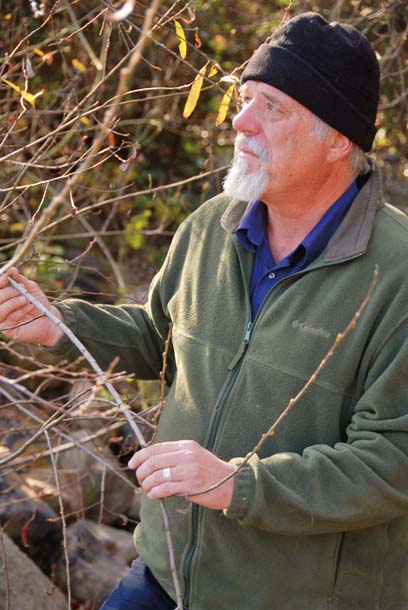
-
Breck Parkman: “I’ve seen foragers strip seaweed from rocks, engage in unlimited poaching, and gather without restraint to make a few quick bucks.” Photo by Damon Tighe.
So it’s no wonder that Breck Parkman, who has worked for the state parks system and foraged for much of his life, says it’s time to enforce the rules. “I’ve seen foragers strip seaweed from rocks, engage in unlimited poaching, and gather without restraint to make a few quick bucks,” Parkman says. “Foragers trample the ground, erode the soil, and remove foods essential for the survival of native animals.”
Burly, bearded, and soft-spoken, master mushroom hunter Mike Twyford asserts that if current practices continue, bountiful foraging will become a thing of the past. As a teenager in Virginia, Twyford picked wild strawberries and brought them home to his mother. Later, in the Philippines, he gathered guavas and mangoes, and in the Australian outback he collected edible cactus flowers. In the Bay Area, in the winter of 2010-11 he brought home more mushrooms than ever before, thanks to steady rains, warm weather, and decades of practice. Twyford doesn’t sell the mushrooms he finds, though chefs have begged him to become a professional forager. He doesn’t need or want the money. It’s the solitude of the outdoors that he craves–whole days spent alone in fields, forests, and mountains. If he didn’t find a single mushroom, he’d still be a happy man.
“My spots are secret,” he told me on a cool afternoon under the shade of a pine tree. “People will grab yours if you tell them where you go. They want the sensation of finding and taking home exotic mushrooms, an experience that can be almost as profitable as finding gold.”
The first foragers Twyford encountered were poor, rural African Americans who foraged, fished, and scavenged to survive. They were wise enough to take only what they needed to feed their families. “I learned from them how fragile the environment is and how essential it is to leave as small a footprint as possible,” Twyford said. “I pick up garbage left behind by hikers and foragers. I don’t disturb grass, twigs, or leaves. When I depart, the area looks exactly as it did when I arrived.”
Mushrooms may be the heart of commercial foraging in California, but the 21st-century foraging movement goes well beyond fungi, giving rise to foraging classes and teachers such as Kevin Feinstein, one of the most visible members of ForageSF, a leading local organization for foragers. With Marin County naturalist and forager Mia Andler, Feinstein has written a new book, The Bay Area Forager, that conveys much of his own energy as a kind of pilgrim at play in the fields of the Lord. The Bay Area Forager emphasizes environmental sustainability, but it also dwells on self-reliance, an American trait that, left unchecked, has too often led to the devastation of forests and the extinction of species.

-
Jonah Raskin on hiking with Kevin Feinstein: “On that day with Kevin Feinstein, we looked with fresh eyes at familiar native shrubs and trees such as madrone and manzanita.” Photo by Damon Tighe.
Feinstein is not unaware of the dilemma: “If everyone in the Bay Area foraged and ate wild foods, the plants would be gone in ten seconds,” he told a group of baby boomers he was guiding across private property–with the owner’s permission. On that winter day near Glen Ellen, I learned to look with fresh eyes at familiar native shrubs and trees such as madrone and manzanita. I came away with a deeper appreciation of a landscape close to my home and with new information about edibles such as miner’s lettuce that I now recognize, and harvest, along the sides of roads.
In Golden Gate Park later in the season, Feinstein led an energetic group that included two young Stanford students who had taken an “edible botany” class and gathered edible fruits on campus to fulfill a class assignment. There was also a spry old woman who told stories about hunting wild mushrooms in the forests of Europe. Not heeding Feinstein’s rules, she was picking and eating nearly everything in sight.
“It’s illegal to forage in Golden Gate,” Feinstein told the group. “If someone asks us: we’re not foraging. Got it ‘”
Feinstein said little about ecology or ethics, except to insist that “foragers can help the environment,” and that “foraging is about looking at and talking about plants.” Fair enough, but he didn’t confront the central dilemma of whether it’s right to encourage the collection of limited, protected resources for individual consumption in a densely populated region. His main lessons were about how to stay safe: By the end of the afternoon, his students knew the difference between poison hemlock and Queen Anne’s lace. They also knew that the tops of hills and knolls are safer for foraging than the flatlands littered with dog feces and trash.

-
Iso Rabins: “It’s amazing the abundance of life under the surface of the ocean.” Photo by Damon Tighe.
Iso Rabins, the founder of ForageSF, spends as much time cooking for the Wild Kitchen, a San Francisco organization that prepares and serves mostly foraged foods, as he does outdoors foraging. Born in Santa Cruz, he began his forays in 2005 and still considers himself a neophyte. His “newest love,” he told me, is diving off the California coast for abalone and sea urchins.
“It’s amazing, the abundance of life under the surface,” he explained to a group of food lovers at a Wild Kitchen feast held last fall in a Mission District loft. Almost everything about the meal was unusual: the ingredients, the price, the ambience, and the feeling of being a part of a food movement–or fad–that would probably never make it into mainstream America. The atmosphere was rarefied, though the idea was to educate eaters from all walks of life about how tasty wild foods can be. The homeless men and women scavenging in trash cans below on Mission Street would never be able to afford the $100 Rabins charges for his dinners.
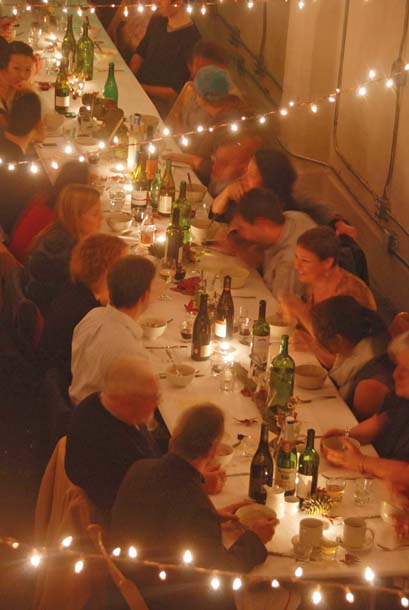
-
For the group ForageSF, collecting wild food has gone from hobby to business, with guests paying $100 or more each for special meals. Photo by Damon Tighe.
Twelve times a year, Rabins and friends prepare a six-course gourmet meal made from foraged and gleaned ingredients such as quail eggs, sea beans (pickleweed), smelt, and plums, along with non-foraged foods such as steak from local cattle. Rabins gathers many of the ingredients himself, though he also relies on other foragers for fruits and fish. Even at $100 a pop, Wild Kitchen has a loyal following among Bay Area foodies such as Pete and Sam, a young San Francisco couple. “We drive to Marin and steal plums,” Sam said gleefully. “Our kids pick and eat sea beans [pickleweed] right out of the water.”
When we talked a week after the Wild Kitchen dinner, Rabins had changed his tune: He emphasized scarcity rather than abundance, though the Wild Kitchen website continued promoting the plentitude of kelp, cod, squid, walnuts, boar, snails, and acorns. “Abalone has been overharvested; it’s an endangered species,” Rabins told me. “Gathering edible bird eggs on the Farallon Islands nearly wiped out whole species.” There’s a long way between ForageSF’s niche dinners and 19th-century Farallon egg companies feeding gold miners, but Rabins’s group does have a stated goal of creating “a situation where foraging full-time can be a sustainable lifestyle.”
For ecologist, teacher, and author Sasha Duerr, when it comes to foraging, ethics come first. Born in Maine and raised there and in Hawaii, Duerr now teaches at the California College of the Arts in Oakland and Berkeley’s Edible Schoolyard, where students learn to grow organic vegetables and make healthy meals. During the day we spent together in Sonoma, Duerr emphasized that hunters, gatherers, and backpackers ought to know the cultural history of their own bioregion. And all of us, whether we forage or not, ought to take walks, notice what we see, and perhaps most of all “listen to Bay Area plants and learn the stories they have to tell.”
Some stories are basic biology: Harvesting roots (or sea urchins, for that matter) means death to an organism, whereas mushrooms and berries are fruiting bodies that grow back year after year. Some plants are rare natives, others invasive weeds. Deciding what might be a sustainable harvest of any wild food is no easy feat.

-
Sasha Duerr: “Listen to Bay Area plants and learn the stories they have to tell.” Photo by Damon Tighe.
Duerr says she’s learned a great deal from California Indians, many of whom have a wealth of information about the natural world. Kathleen Smith, a Pomo Indian, grew up listening to her mother and grandmothers tell stories about plants such as spicebush and soap plant. She retold some of those stories to a group of hikers and herbalists, myself included, at a retreat at Pepperwood Preserve in Sonoma County. Smith talks to plants and tells them how they’ll be “transformed” after they’re harvested for cooking, medicine, or the making of baskets. She explained that her Indian ancestors didn’t “forage” in the sense of simply finding wild foods; they removed weeds, tilled the soil, irrigated plots, and burned vegetation to stimulate new growth.
“Indians do not take without asking and we always give thanks,” Smith told me when I asked if she continued the practices of the past. “We only take at specific times of the year and in specific places. Moreover, we never take everything.” But how can such traditions be re-created in a modern metropolis of seven million people?
After a year of talking about foraging it was time to plunge into the wilds and do it myself. On a warm day after Thanksgiving, I grabbed my foraging books, put on boots, and drove to a spot in West Marin where foragers promised I’d find mushrooms. Along the road, there were no signs that read “Keep Out” and the broken fence was easy to climb. I knew the property was private and that I could be arrested for trespassing. It was a risk I was willing to take. Something beckoned: the call of the wild, the call of the wild mushrooms. Yet I felt like an outlaw, so I moved with deliberate speed.
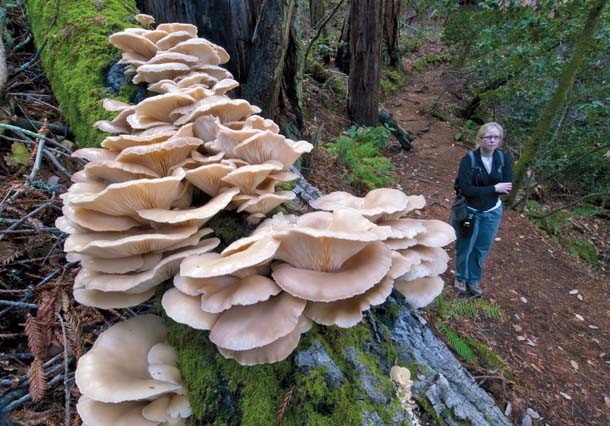
-
These oyster mushrooms look ideal for the saute pan, but they’re at Muir Woods National Monument, where all foraging is prohibited. Photo by John W. Wall.
In a few minutes, my “mushroom eyes,” as I call them, spied a thick patch of chanterelles, their orange caps poking above the surface. Others were concealed beneath dry oak and bay leaves that I removed with my fingertips. I took nothing from under the ground, and I gathered modestly. Everything I’d heard all year long from mushroom gatherers echoed in my head: “Mushroom hunting connects you to the land like nothing else.” “Don’t be greedy.” “Leave the spot undisturbed.” What my teachers hadn’t prepared me for was the beauty of the wild mushrooms and the aesthetics of the whole experience.
After an hour, I had enough chanterelles for several meals. Back in my kitchen, I opened my foraging sack and immediately the aroma of the mushrooms, the woods, and the late fall afternoon filled the room. I added olive oil to a skillet, sauteed the mushrooms, sat down to eat, and felt at last that I belonged to the ancient tribe of mushroom hunters and mushroom eaters the world over.
But like most of the mushroom hunters I knew, I had trespassed. I had lived up to only half of the foraging maxim that John McReynolds had shared with me near the start of my adventure. I’d taken advantage of the right to forage, but I had done so without permission from the owner.
I remember a day when I went into the wilds with a friend who taught me how to distinguish poisonous from non-poisonous mushrooms. He couldn’t stop himself from harvesting mushrooms, even though he had more than he needed. He seemed possessed by foraging fever. I reminded him of his own oft-repeated words to me, “Don’t be greedy.” When he continued to take chanterelles hand over fist, I pulled him away. Old habits and old attachment do not die easily, even with the best of intentions. If we mean to create “right relationships” with the earth, we will have to pull ourselves and perhaps even our friends away from conventional temptations to take all there is, and instead leave some for other creatures that depend on those nutrients to survive. And perhaps we’ll have to resist old war stories about the glories of hunting, whether for wild boar or wild mushrooms, and begin to tell stories about how particular places, plants, and animals sustain us–and what we must do to sustain them.

.jpg)

